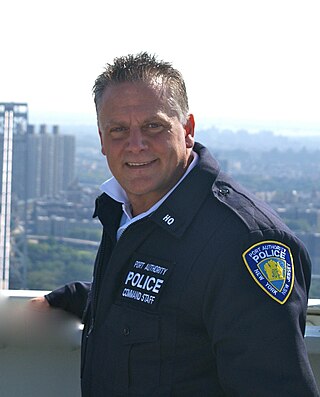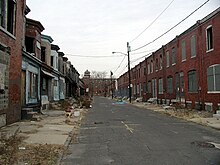
Camden County is a county located in the U.S. state of New Jersey. Its county seat is Camden. As of the 2020 census, the county was the state's ninth-most populous county, with a population of 523,485, its highest decennial count ever and an increase of 9,828 (+1.9%) from the 2010 census count of 513,657, which in turn reflected an increase of 4,725 (0.9%) from the 508,932 counted in the 2000 census. The county is part of the South Jersey region of the state.

Camden is a city in Camden County, in the U.S. state of New Jersey. It is part of the Delaware Valley metropolitan region. The city was incorporated on February 13, 1828. Camden has been the county seat of Camden County since the county's formation on March 13, 1844. The city derives its name from Charles Pratt, 1st Earl Camden. Camden is made up of over 20 neighborhoods, and is part of the South Jersey region of the state.

Haddon Township is a township in Camden County, in the U.S. state of New Jersey. As of the 2020 United States census, the township's population was 15,407, an increase of 700 (+4.8%) from the 2010 census count of 14,707, which in turn reflected an increase of 56 (+0.4%) from the 14,651 counted in the 2000 census.

Lawnside is a borough in Camden County, in the U.S. state of New Jersey. Lawnside was developed in 1840 and incorporated in 1926 as the first independent, self-governing Black municipality north of the Mason–Dixon line. The United Parcel Service has a large depot in the borough. As of the 2020 United States census, the borough's population was 2,955, an increase of 10 (+0.3%) from the 2010 census count of 2,945, which in turn reflected an increase of 253 (+9.4%) from the 2,692 counted in the 2000 census.

Lindenwold is a borough in Camden County, in the U.S. state of New Jersey. As of the 2020 United States census, the borough's population was 21,641, an increase of 4,028 (+22.9%) from the 2010 census count of 17,613, which in turn reflected an increase of 199 (+1.1%) from the 17,414 counted in the 2000 census.

Woodlynne is a borough in Camden County, within the U.S. state of New Jersey, and a suburb located 4 miles (6.4 km) southeast of Philadelphia. As of the 2020 United States census, the borough's population was 2,902, a decrease of 76 (−2.6%) from the 2,978 recorded at the 2010 census, which in turn reflected an increase of 182 (+6.5%) from the 2,796 counted in the 2000 census. The borough is the state's eighth-smallest municipality. Established on the site of a defunct amusement park, the entire borough of Woodlynne is less than one-third the size of Six Flags Great Adventure and Safari.

Pagan's Motorcycle Club, or simply the Pagans, is an outlaw motorcycle club formed by Lou Dobkin in 1957 in Prince George's County, Maryland, United States. The club rapidly expanded and by 1959, the Pagans, originally clad in blue denim jackets and riding Triumphs, began to evolve along the lines of the stereotypical one percenter motorcycle club.
Crime in Washington, D.C., is directly related to the city's demographics, geography, and unique criminal justice system. The District's population reached a peak of 802,178 in 1950. Shortly after that, the city began losing residents, and by 1980 Washington had lost one-quarter of its population. The population loss to the suburbs also created a new demographic pattern, which divided affluent neighborhoods west of Rock Creek Park from the less well-off neighborhoods to the east.

Established in April 1857, the Newark Police Department (NPD) is the primary law enforcement agency serving Newark, New Jersey and the largest municipal law enforcement agency in New Jersey. As of December 2017 the force had 1,146 officers.
The Camden Police Department (CPD) was the primary civilian law enforcement agency in Camden, New Jersey, until it was dissolved on May 1, 2013, when the Camden County Police Department Metro Division took over full responsibility for policing the city of Camden.
Crime in Atlanta, Georgia is above the national median and has been a major problem for the city since the middle 20th century.
Gilbert L. "Whip" Wilson is an American Democratic Party politician who has been the sheriff of Camden County, New Jersey since December 2015. He served in the New Jersey General Assembly from 2010. when he was selected by party leaders to fill the vacant seat of Donald Norcross who had moved up to the New Jersey Senate, until December 2015 when he resigned in order to take office as sheriff. While in the Assembly, he represented the 5th Legislative District. Wilson was a councilman at-large in the City of Camden from 1997 to 2000 and again from 2005 to 2010.
As of 2013, there was a reported 192,971 crimes in the U.S. state of New Jersey, including 401 murders. This is an overall decrease in total crimes reported, but an increase in murders.

Gerald Speziale is an American law enforcement officer and Public Safety Director of the Paterson Police Department and the Paterson Fire Department in Paterson, New Jersey. A former member of the New York City Police Department, Speziale has also served as the Sheriff of Passaic County, New Jersey, as Deputy Police Superintendent - Assistant Director of Public Safety for the Port Authority of New York and New Jersey Police Department, and as Chief of Police for the City of Prichard, Alabama. He has worked as an undercover officer in the United States Drug Enforcement Administration (DEA), and for the New York Drug Enforcement Task Force while in the NYPD.
Whitman Park is a neighbourhood in Camden, New Jersey. Located north of Woodlynne, Whitman Park has a population of 6,981.
History of Camden, New Jersey starts with the introduction of Quakers into the native lands of the Lenape population in the Delaware Valley. Throughout the city's history there have been times of economic growth and development; as well as stagnation and decline. The City of Camden was named after Camden County, which was named for Charles Pratt, 1st Earl Camden, who was a civil libertarian, promoter of the American cause, and a British judge and lawyer. The city was incorporated on February 13, 1828.
Police unions in the United States include a large number and patchwork variety of organizations. Of those unions which conduct labor negotiations on behalf of its police members, 80% are independent and have no affiliation to any larger organized labor groups. There were a reported 800,000 sworn officers in the United States as of 2017, and an estimated 75–80% of them belonged to a union.
Camden, New Jersey once had a national reputation for its violent crime rates, although recent years have seen a significant drop in violent crime, with 2017 seeing the lowest number of homicides in three decades.










